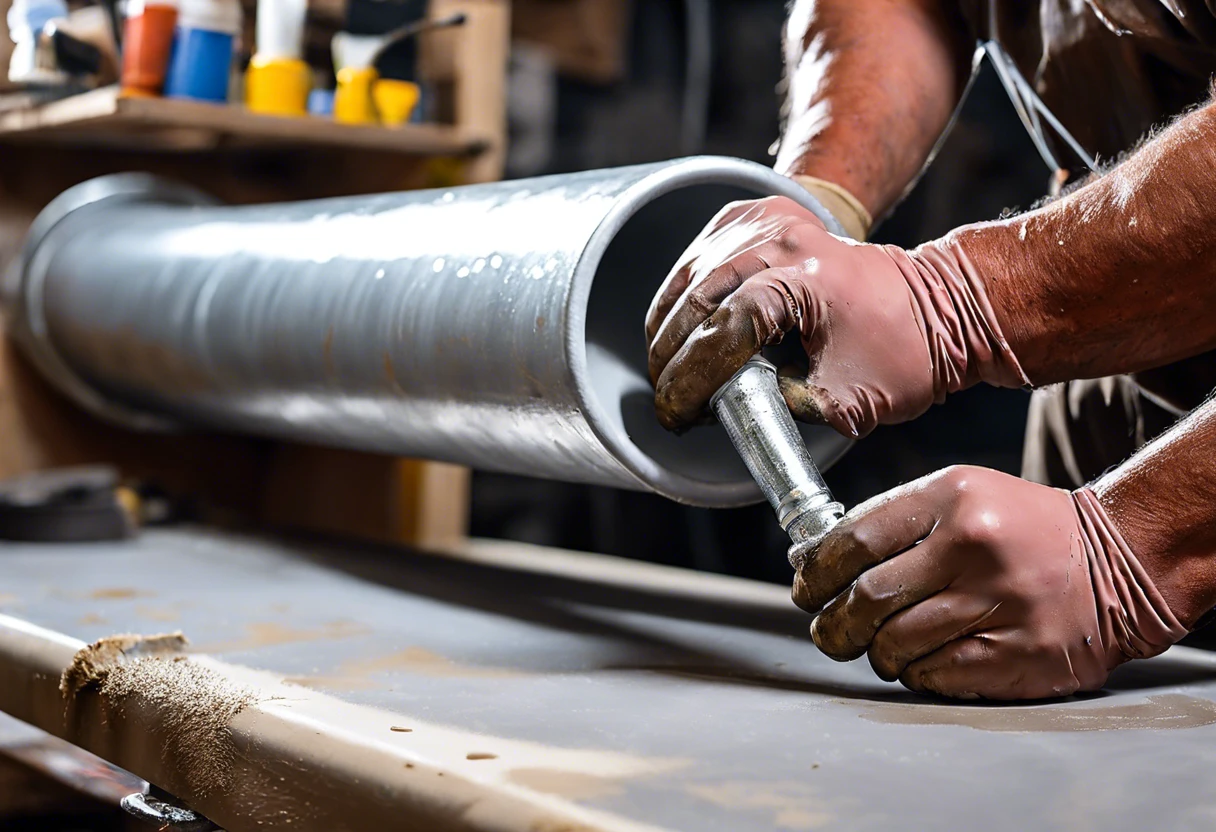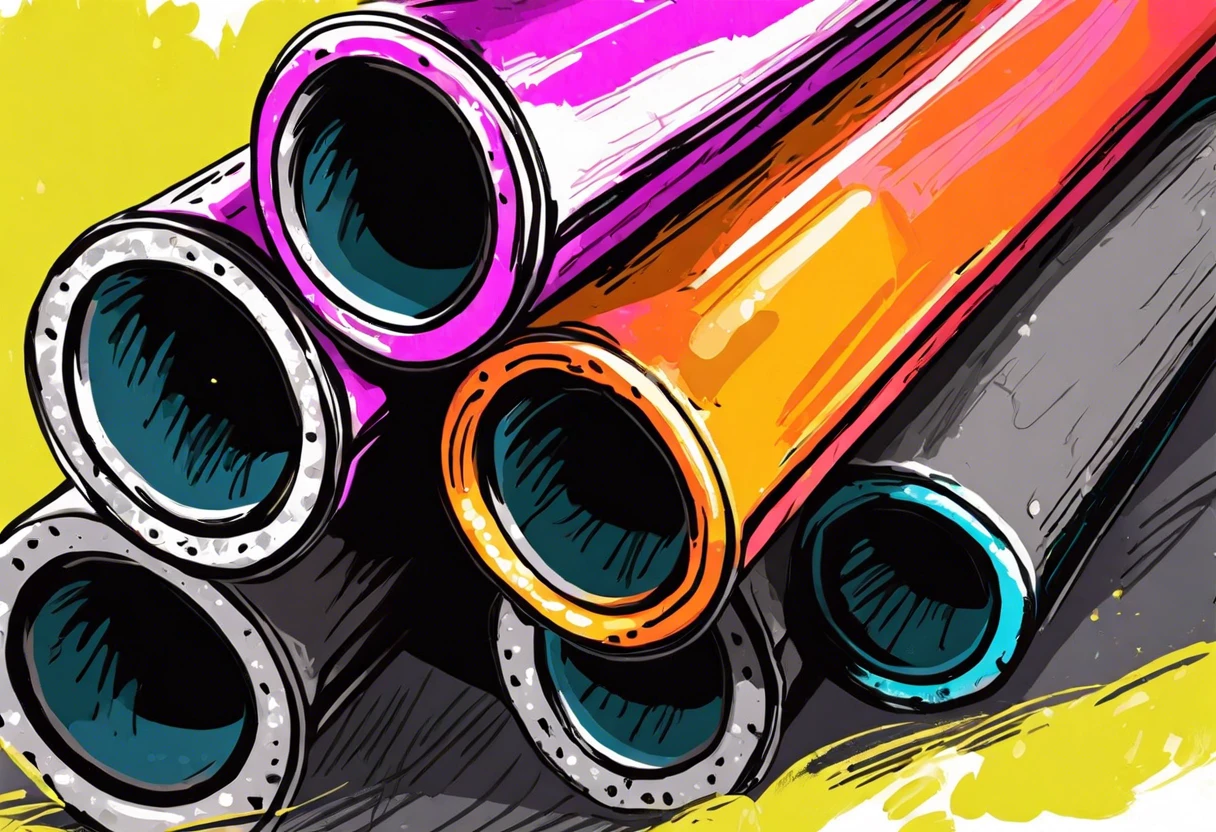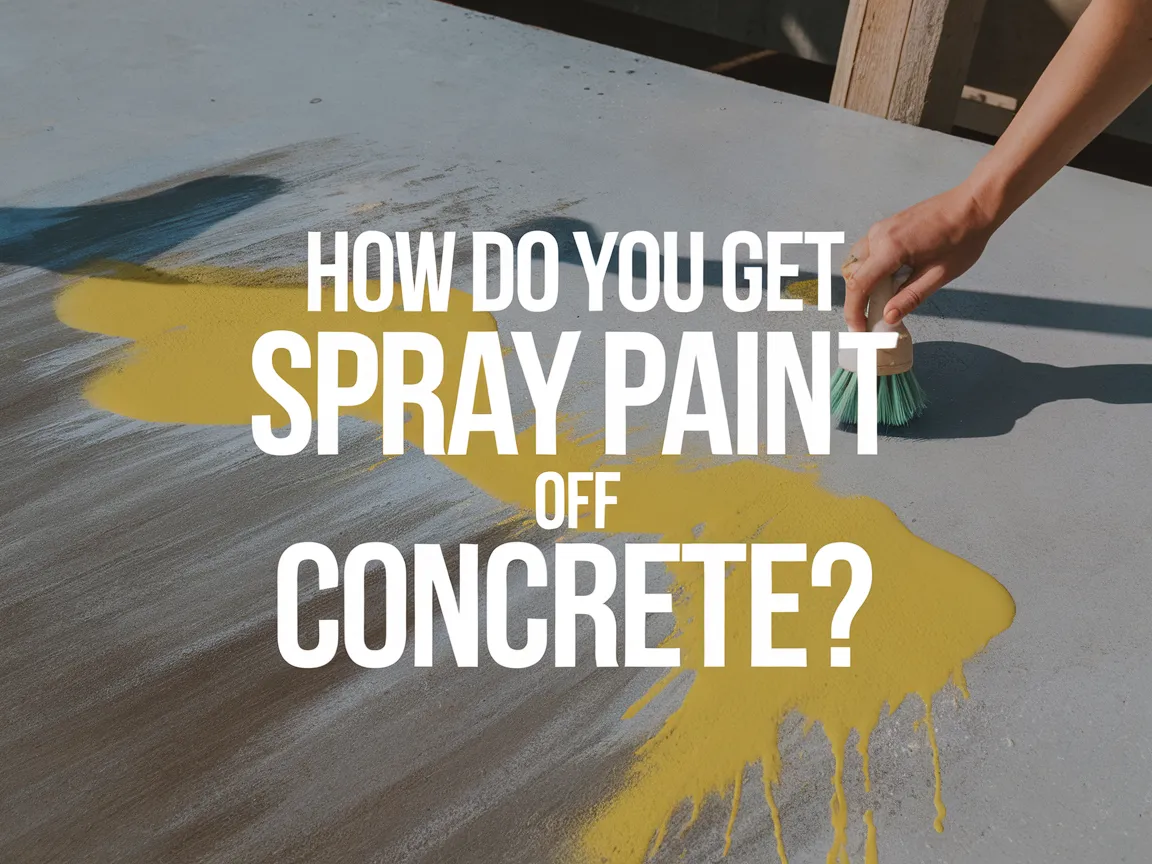How Do You Paint Galvanized Pipe?
Published on: February 4, 2025 | Last Updated: January 7, 2025
Written By: Alisha Winters
Galvanized pipe is metal pipe covered with a protective zinc coating. This coating helps prevent rust and corrosion, making it useful for plumbing and construction.
When you ask how do you paint galvanized pipe, it’s crucial to follow the right steps. I’ve learned that proper preparation makes a world of difference in the final look!
In this guide, I’ll cover essential preparations before painting, steps for painting galvanized pipe, recommended paint colors, types of paint to use, and common issues to watch out for. You’ll discover everything you need to know about how to paint galvanized steel pipe.
Contents
- 1 How Do You Paint Galvanized Pipe?
- 2 What is Galvanized Pipe?
- 3 Essential Preparations Before You Start Painting
- 4 Comprehensive Steps to Paint Galvanized Pipe
- 5 Recommended Color Palette for Painting Galvanized Pipe
- 6 Types Of Paint Best Suited for Galvanized Pipe
- 7 Factors Affecting the Outcome Of Painting Galvanized Pipe
- 8 Common Issues Encountered When Painting Galvanized Pipe
- 9 Finishing Touches for a Professional Look
- 10 Inspection for Quality Assurance
- 11 Tips for Maintaining Painted Galvanized Pipe
- 12 Creative Techniques for Customizing Painted Galvanized Pipe
- 13 Estimating the Amount of Paint Needed for Galvanized Pipe
- 14 Alternative Finishing Techniques for Added Style
- 15 Understanding Paint Curing Times
- 16 Advanced Tips for the Experienced Painter
- 17 Frequently Asked Questions About Painting Galvanized Pipe
- 18 Conclusion
- 19 Useful Resources
How Do You Paint Galvanized Pipe?
To paint galvanized pipe, start by cleaning it with soap and water. Next, use a wire brush to remove any rust. Then, apply a primer made for metal surfaces. Finally, paint with a high-quality exterior paint. If you’re curious about specialized coating techniques for different paint finishes, ceramic coating offers unique protection.
What is Galvanized Pipe?
Galvanized pipe is steel pipe coated with zinc to prevent rust and corrosion. The zinc coating provides a durable shield, allowing these pipes to last for decades, often over 50 years.
If you’re wondering how to paint galvanized pipe, it requires special attention. I’ve painted these pipes before, and a good primer is crucial for strong adhesion.
Once, I painted a galvanized pipe for a DIY project in my garage. It’s not just about the paint; prepping the surface is essential for longevity. If you’re interested in how to paint metal surfaces, using the right methods greatly enhances durability and appearance. When working with different materials like plastic, you might want to explore specific painting techniques that ensure proper paint adhesion.
Essential Preparations Before You Start Painting
What do you need to prepare?
- Galvanized Pipe Cleaner: Use a cleaner like Rust-Oleum® Zinc Preprimer to remove grease and prepare the surface.
- Wire Brush: Choose a medium-grade brush such as Newell’s Steel Wire Brush to remove rust and corrosion from the pipe’s surface.
- Primer: Apply an oil-based primer, such as Rust-Oleum® Safety Yellow, which adheres well to metals and prevents rust.
- Protective Gear: Don’t forget gloves and a mask, like 3M N95 Respirators, to protect yourself from fumes and dust.
We covered necessary preparations before painting. We will now cover detailed steps for painting galvanized pipe.
Also See: Can Galvanised Steel Be Painted? How to Do It Easily!

Comprehensive Steps to Paint Galvanized Pipe
Here are the essential steps to effectively paint galvanized pipe.
-
Clean the Galvanized Pipe Thoroughly
Scrub the surface with a wire brush or scouring pad. This step is crucial; a clean surface helps the paint adhere better.
Use a solution of water and dish soap to remove oil and dirt, then rinse thoroughly and let it dry completely to avoid trapping moisture under the paint.
-
Apply a Suitable Primer
Choose a zinc chromate primer designed for metal surfaces. Apply it evenly with a brush, roller, or spray can for best results—don’t skimp!
Allow the primer to dry completely, usually for 1-2 hours. This creates a solid base for the paint and extends its durability.
-
Choose the Right Paint Type
Select an oil-based or epoxy paint formulated for metal surfaces. These paints offer durability and corrosion resistance, which is essential for exposed pipes.
Always check the manufacturer’s recommendations. Using a Rust-Oleum label often yields the best results. Ensure it’s compatible with your primer.
-
Apply the Paint Evenly
Start painting the pipe with thin, even coats. Less is more; aim for 2–3 light coats instead of one thick coat for a smoother finish.
Allow each coat to dry completely, generally taking 4-6 hours for oil-based paints. This prevents drips and gives a professional look.
-
Allow Adequate Drying Time
After applying the final coat, let the paint cure properly. Most paints require 24–48 hours to fully cure, depending on temperature and humidity.
Check the paint can for specific curing times. Rushing this step can lead to scratches and damage; it’s worth the wait!
We’ve wrapped up the comprehensive steps for painting galvanized pipe here. Let us turn our attention to the recommended color palette.
Recommended Color Palette for Painting Galvanized Pipe
I suggest using a ‘Modern Industrial’ palette to beautifully blend with metal surfaces, creating a sleek yet inviting look.
| Color Box | Hex Code | Color Name |
|---|---|---|
| #4A4E69 | Charcoal | |
| #9A8C98 | Lavender Grey | |
| #C9ADA7 | Light Taupe | |
| #F8EDD4 | Peach Cream |
So far we covered the suggested color schemes for painting galvanized pipes. Let’s look at the best paint types for galvanized pipes next.
Types Of Paint Best Suited for Galvanized Pipe
Let’s move on to paint types: primer, spray paint, brush-on paint, and epoxy paint.
-
Primer
A primer is essential for galvanized surfaces. Choose a zinc-rich primer to prevent rust and ensure long-lasting adhesion, ideally applied at a thickness of 0.5 mils (0.0127 Mm).
-
Spray Paint
Spray paint provides a smooth finish for your galvanized pipe. It typically dries faster than other types, with most varieties fully curing within 24 hours.
-
Brush-on Paint
Brush-on paint gives you more control, making it perfect for intricate designs. Ensure it’s formulated for metal and offers zinc protection for effectiveness.
-
Epoxy Paint
This paint type offers durability and chemical resistance. Epoxy paint cures hard within 12 to 24 hours, making it ideal for harsh environments.
I’ve found that epoxy paint is a game changer for galvanized pipes due to its strength. Its long-lasting finish makes it perfect for outdoor durability.
We’ve wrapped up the various types of paint ideal for galvanized pipe here. Let us turn our attention to factors influencing the painting results.

Factors Affecting the Outcome Of Painting Galvanized Pipe
What factors impact your approach to painting galvanized pipe?
-
Surface Preparation: Clean the pipe properly for better paint adhesion.
-
Type of Paint: Use paint designed for metal to prevent rust and peeling.
-
Environmental Conditions: Temperature and humidity affect drying times and finish quality.
-
Application Method: Brushing, spraying, or rolling creates different thicknesses and appearances.
Common Issues Encountered When Painting Galvanized Pipe
My friend once struggled with painting galvanized pipe. The paint didn’t stick, flakes coming off after a few days. Frustrating, right?
To fix this, clean the pipe with a wire brush and use a primer made for galvanized surfaces. Aim for 200–300 grams/m² (0.1–0.15 Pounds/ft²) of primer for the best adhesion.
Finishing Touches for a Professional Look
After painting your galvanized pipe, let it cure for at least 24 hours before exposure to moisture. Use a high-quality exterior topcoat, like Rust-Oleum, to enhance longevity.
Inspection for Quality Assurance
Inspect your galvanized pipe weekly for rust spots or peeling paint, especially after heavy rain. Use a wire brush to keep it clean and ensure the protective layer stays intact.
Tips for Maintaining Painted Galvanized Pipe
Once you’ve painted your galvanized pipe, keeping it in good shape matters. Here are some tips on how to maintain that fresh look.
-
Regular Inspections
Check the painted surface monthly. Look for any signs of rust or peeling paint. Early detection can save you time and money!
-
Wash with Mild Soap
Use a solution of mild soap and water to clean the surface. Avoid harsh chemicals that can degrade the paint over time.
-
Reapply Touch-Up Paint
If you notice chips or scratches, touch them up immediately. This can help retain protection and keeps it looking sharp.
Creative Techniques for Customizing Painted Galvanized Pipe
Want to take your galvanized pipe game to the next level? Here are some innovative techniques to add flair to your painted pipes.
-
Ombre Effect
Try blending two or more colors for a stylish ombre effect. Start with a lighter shade at the top and gradually transition to a darker shade at the bottom. This technique can create a beautiful gradient that draws attention!
-
Geometric Patterns
Use painter’s tape to create sharp geometric patterns. Simply tape off sections before painting. It’s an affordable way to add modernism and design elements to your décor.
-
Chalkboard Paint
Want functionality and style? Use chalkboard paint to make your pipes writable. This way, you can jot down notes or decorate them with fun doodles!
Estimating the Amount of Paint Needed for Galvanized Pipe
Wondering how much paint to buy? Here’s a quick breakdown!
| Pipe Diameter (inches) | Length (feet) | Paint Required (ounces) |
|---|---|---|
| 1 | 10 | 12-16 |
| 2 | 10 | 20-24 |
| 3 | 10 | 30-36 |
As you can see, larger pipes need more paint. Keep this in mind to avoid multiple trips to the store!
Alternative Finishing Techniques for Added Style
Want to spice things up? Here are some creative finishing techniques!
-
Stencil Art
Consider adding stencils for designs. Use weather-resistant paint for longevity. This can give a unique touch!
-
Rustic Finishes
Add a rustic finish by using a sponge technique with different shades of paint to give your galvanized pipe a vintage look.
Also See: Can You Paint Contact Paper? Yes, Here’s How.
Understanding Paint Curing Times
Curing time impacts the durability of your painted pipe. Here’s a breakdown:
| Paint Type | Touch Dry Time | Cure Time |
|---|---|---|
| Oil-Based Paint | 4-6 Hours | 24-48 Hours |
| Acrylic Paint | 1-2 Hours | 6-12 Hours |
| Epoxy Paint | 1-2 Hours | 12-24 Hours |
Advanced Tips for the Experienced Painter
For professional painters, consider using a spray application with even coats under 50 µm (Micrometers) for a smoother finish and better durability on the galvanized pipe surfaces.
Frequently Asked Questions About Painting Galvanized Pipe
What Type Of Paint Should I Use on Galvanized Pipe?
You’ll want to use a paint designed specifically for galvanized pipe. Paints that contain zinc or galvanizing compound adhere better, ensuring a long-lasting finish. For best results, choose a high-quality acrylic latex or an oil-based paint that can withstand outdoor elements.
Is It Necessary to Use a Primer on Galvanized Pipe?
Yes, it’s necessary to use a primer on galvanized pipe. Priming helps paint to adhere and prevents rust formation by creating a barrier. Using a suitable primer can even improve the paint’s durability against UV rays and moisture, extending the life of your painted surface for years. If you’re wondering about specific coating techniques, painting bed liner methods can provide additional protective insights for metal surfaces.
Can I Paint Galvanized Pipe Without Cleaning It First?
No, you can’t paint galvanized pipe without cleaning it first. Proper cleaning removes oils, dirt, and residues that can prevent adhesion. Use a degreaser or a metal cleaner and rinse thoroughly to ensure a smooth finish. If you want to master the art of surface preparation, check out some expert techniques for painting metal surfaces perfectly.
How Long Does Painted Galvanized Pipe Last Outdoors?
A painted galvanized pipe can last up to 10 years outdoors. Factors like climate, moisture, and coating quality affect this lifespan. By selecting the right materials and applying paint properly, you can stretch its durability significantly. If you’re looking to enhance your painting technique, professional painting methods can provide additional guidance for long-lasting results.
What Should I Do if the Paint is Peeling?
If the paint is peeling, it’s crucial to strip the old paint and assess the surface. Use a sandblaster or chemical remover if necessary, then clean and prime the surface. Repainting with appropriate materials will restore the finish and protect your galvanized pipe again. When working in tight spaces like behind radiators, you might need specialized techniques for painting hard-to-reach areas.
Can Galvanized Pipe Be Painted With Spray Paint?
Yes, galvanized pipe can be painted with spray paint. Make sure to use a spray paint formulated for metal surfaces. This method allows for even coverage and can save time, making it a great option if done correctly! If you’re wondering about alternative painting techniques, chalk paint offers another interesting approach.
How Do I Know if I’ve Adequately Prepared the Galvanized Pipe?
You can tell if you’ve adequately prepared the galvanized pipe by checking for a smooth, clean surface. If it feels gritty or you see shiny areas full of residue, it’s a sign that cleaning or sanding is needed before painting. When selecting the right paint for your project, you might want to explore specific painting techniques for surfaces.
Conclusion
That’s everything I wanted to share with you. We covered what galvanized pipe is, essential preparations, steps to paint, recommended color palettes, best paint types, factors affecting outcomes, common issues, finishing touches, quality inspections, advanced tips, and creative DIY project ideas.
To paint galvanized pipe effectively, ensure thorough cleaning, apply an appropriate primer, and select the right paint for a polished finish. If you have any further questions about painting galvanized steel pipe, feel free to reach out.
For additional insights and tips, be sure to check out Paint Answers.
Useful Resources
- Betti, C., & Sale, T. (2012). Drawing: A Contemporary Approach (6th ed.). Belmont, CA: Cengage Learning.
- The Best Way to Paint a Galvanized Pipe | Hunker
- Painting galvanized steel
- How To Paint Galvanized Steel – Dunn-Edwards Paints
Experienced interior designer with 15+ years in transforming spaces, blending artistry with expertise in color and design. Rhode Island School of Design graduate, specializing in restorations and modern makeovers.
Material, Metal




